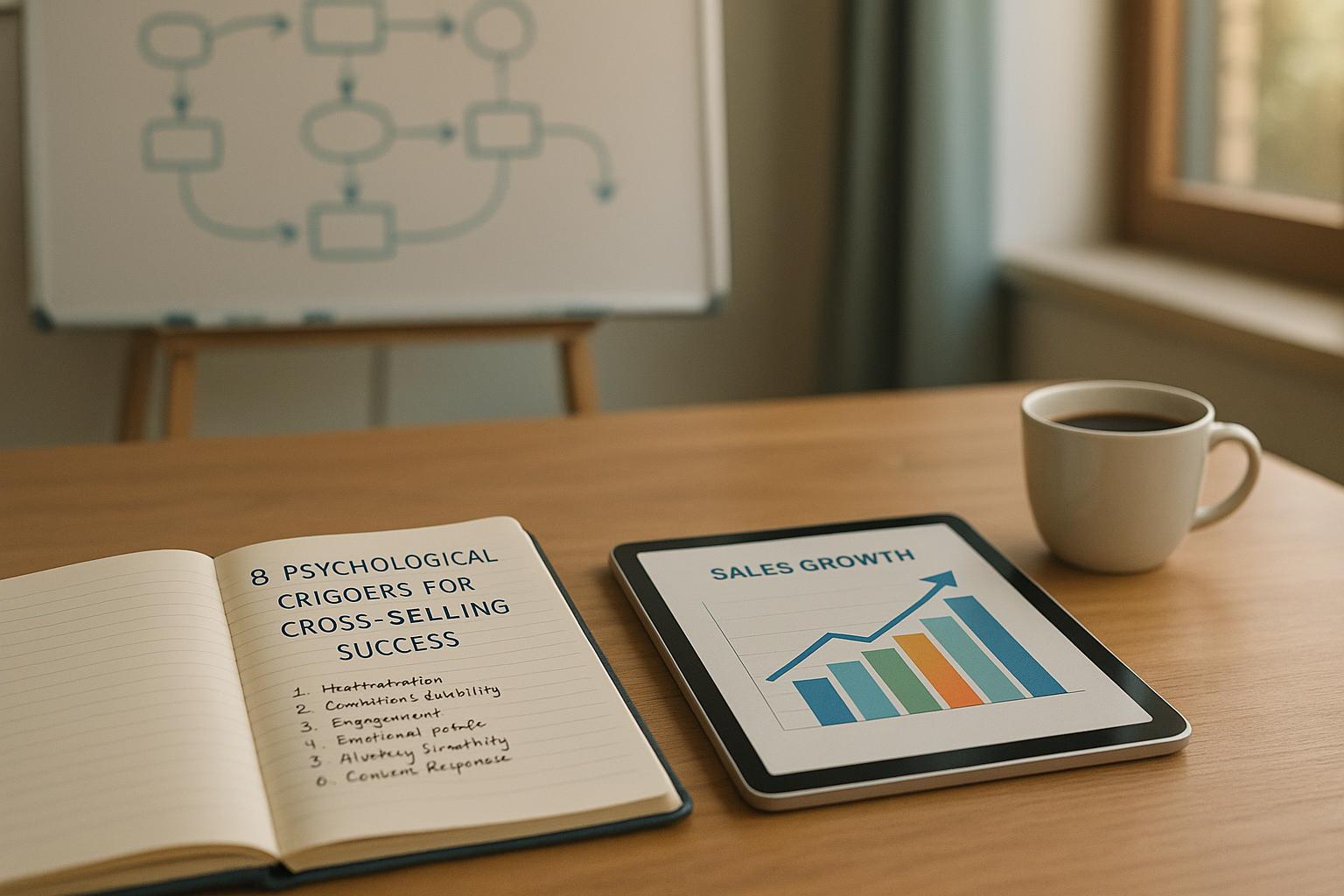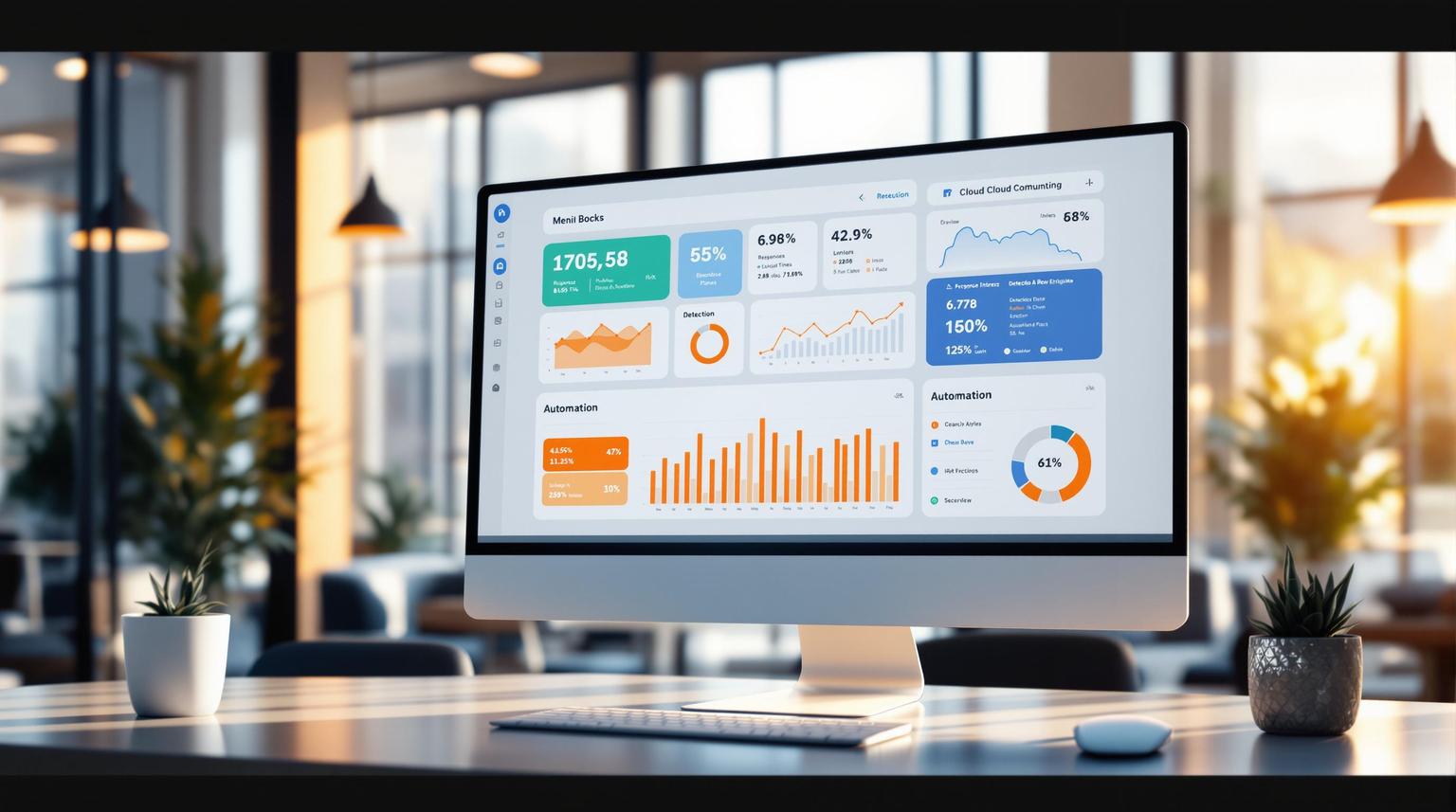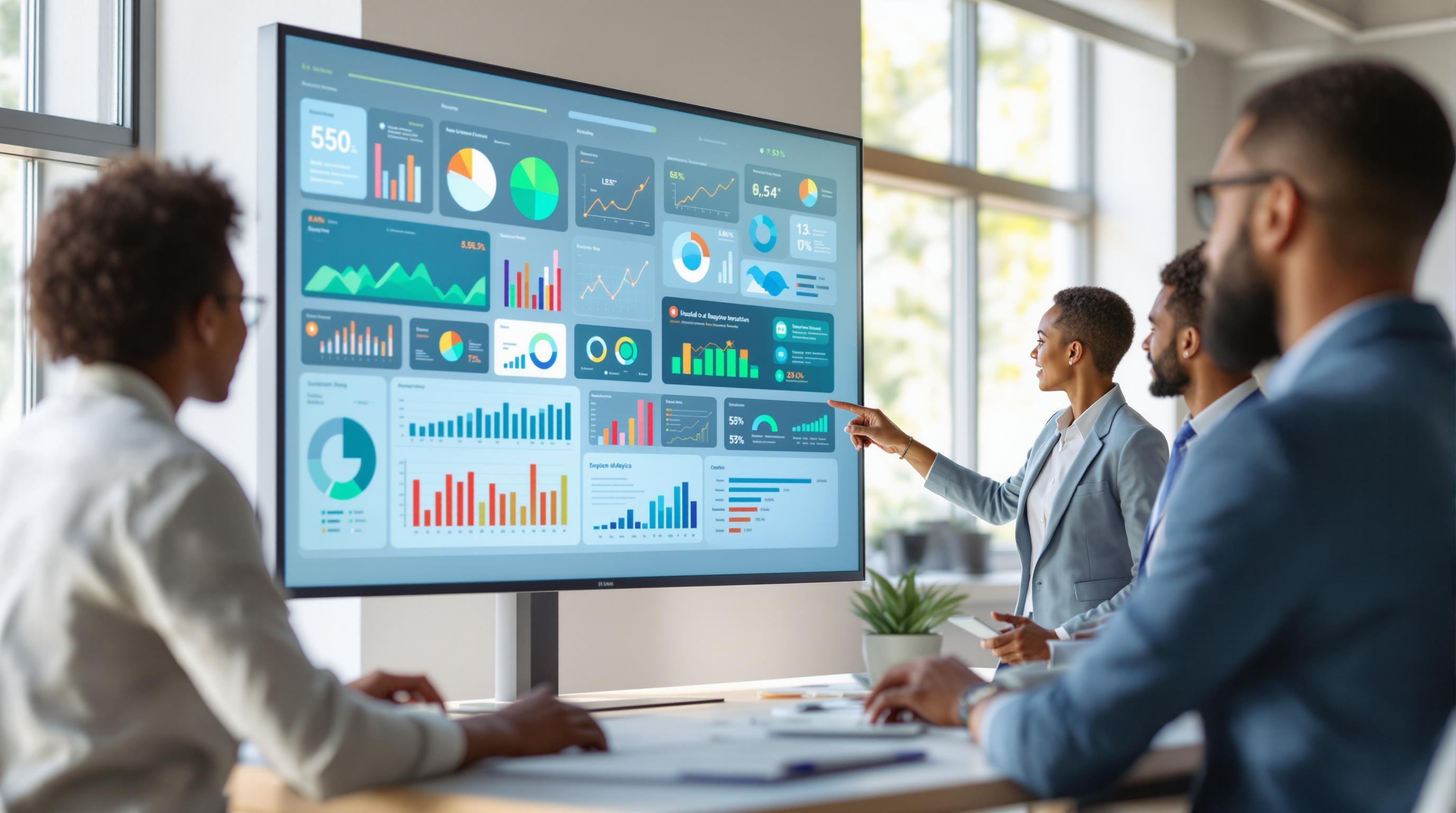Freemium upselling is about converting free users into paying customers by leveraging data insights. Here's the key takeaway: Use user behavior data to identify upgrade opportunities, personalize offers, and time them effectively. SaaS companies like Grammarly, Dropbox, and Canva show that success lies in understanding user needs and creating targeted, timely upgrade prompts.
Key Points:
- Freemium Model Basics: Offer a free tier with limited features to attract users, then encourage upgrades to premium plans.
- Why Upselling Matters: Even small conversion rates (2%-5%) can drive significant revenue; upselling boosts customer lifetime value.
- Data-Driven Upselling:
- Feature-Based Upgrades: Highlight premium features users interact with.
- Usage-Based Triggers: Prompt upgrades when users hit plan limits.
- Personalized Offers: Use behavioral data to craft relevant, timely messages.
- Advanced Tactics: Segment users, analyze cohorts, and use in-app analytics to refine strategies.
- Consulting Support: SaaS companies often rely on experts to optimize upselling strategies, ensuring maximum ROI.
Freemium upselling works best when it's tailored, data-driven, and user-focused. The right mix of tactics can turn free users into loyal, paying customers.
Pricing experts share top tips to turn freemium users into PAYING CUSTOMERS
Data-Driven Upselling Methods
Freemium companies that thrive know how to turn user data into opportunities for upgrades. By analyzing user behavior, they craft strategies that don't just boost revenue but also feel natural and helpful to the user. Let’s dive into some proven tactics.
Feature-Based Upgrades
Understanding how users interact with features can reveal what they value most - and where upgrade opportunities lie.
Take ClickUp, for example. They prominently highlight premium features, and when free users attempt to access one, they’re met with an upsell prompt that showcases the benefits of upgrading. Asana, on the other hand, targets its most engaged users - those who already show interest in advanced features - by presenting them with tailored premium options.
Other companies, like Pendo, go a step further by using in-app behavior to personalize upsell offers. For instance, they introduce relevant premium features and even offer demos to show users exactly what they’re missing out on.
Why does this work? Users already engaged with your product are more likely to upgrade. In fact, upsell conversion rates for freemium users can hit 8%–20%, compared to just 3%–10% for onboarding brand-new users.
Usage-Based Triggers
Real-time usage tracking is another powerful tool. By monitoring when users approach their plan limits, you can strategically prompt upgrades.
Dropbox is a classic example. As users near their storage limit, they’re reminded to upgrade, avoiding the frustration of hitting a hard stop. Similarly, Loom nudges users with recording time limits, emphasizing the perks of unlimited recordings available in higher tiers.
Miro takes a direct approach. When users attempt to create a new board beyond their plan’s limit, they’re informed that existing boards will become view-only unless they upgrade. This creates urgency by clearly showing the consequences of sticking to the free plan.
Automated triggers can track a variety of limits - whether it's storage, user count, API calls, or feature usage. Zapier, for instance, uses in-app banners to remind users about trial periods for paid features, adding a sense of urgency.
Personalized Offers Using Behavioral Data
Generic upgrade prompts often fall flat. Instead, tailoring offers based on user behavior can make them feel more relevant and compelling.
Grammarly does this well by letting users try premium features up to three times a day. Once they hit that limit, an upgrade prompt appears, allowing users to experience the value before committing. Canva takes a different angle during downgrades. As users near the end of a premium trial, Canva highlights how often they used certain premium features, nudging them to reconsider upgrading.
Real-time data can help pinpoint the perfect moments for these personalized nudges. For example, one SaaS company boosted retention by 25% by analyzing login frequency and feature usage to identify at-risk customers, then sending tailored emails and in-app tips. Airtable combines these in-app prompts with email campaigns to make upsell messages feel timely and relevant.
Timing Upgrade Prompts
When you ask users to upgrade is just as important as how you ask. The key is to identify moments when an upgrade feels natural rather than intrusive.
Intercom does this by gating advanced features after users have invested time with the basic ones. This creates a natural friction point that encourages upgrades. Similarly, Spotify allows free users to skip six tracks per hour, then prompts them to upgrade to premium when they hit that limit. This aligns with user frustration and the desire for more control.
Timing matters. Whether it’s triggered by usage limits, high engagement, or natural breaks in workflow, well-timed upselling can significantly increase customer lifetime value. For example, the average SaaS company generates 16% of its new Annual Contract Value (ACV) through upselling. By tracking key metrics and setting up alerts, businesses can find the perfect moments to introduce upgrade prompts, making the transition feel seamless rather than disruptive.
Using Analytics and User Segmentation
Once you've nailed the basics of data-driven upselling, taking it to the next level with advanced analytics and precise user segmentation can unlock even more revenue opportunities. Instead of relying on generic upgrade prompts, you can create campaigns that feel personal and relevant to your users.
User Segmentation for Targeted Campaigns
Breaking your audience into meaningful segments is a game-changer for conversion rates. Sending the same upgrade message to everyone? That’s old news. Instead, tailor your messaging to match how different groups engage with your product.
Here’s why it works: 80% of consumers are more likely to choose brands that personalize their experiences. On top of that, 98% of marketers say personalization strengthens customer relationships, and 88% of U.S. marketers report measurable performance boosts from it. Targeted campaigns can deliver three times more conversions compared to generic messaging.
"Most SaaS executives think that what you charge will determine your success. In fact, who and how you charge determines your success. Segmentation is the first step to SaaS pricing success." – Dan Balcauski
Identifying your high-value users - those who significantly contribute to your Average Customer Value - is essential. Segmentation can focus on engagement levels, such as distinguishing active users from inactive ones, or analyzing behaviors like page visits, feature signups, and upgrade attempts. For freemium models, targeting free trial users with in-app messages or using NPS data to time your upgrades can be especially effective.
Once you’ve segmented your audience, cohort analysis can provide even deeper insights into user behavior.
Cohort Analysis to Track Conversions
If segmentation helps you group users, cohort analysis helps you understand how these groups evolve over time. By categorizing users based on when they signed up or performed specific actions, you can track their progression from free to paid.
This method doesn’t just show current trends - it can also predict future drivers of growth, such as expansion, churn, or contraction in Monthly Recurring Revenue (MRR). It’s a valuable tool for forecasting.
"Cohort renewal rate is mostly backward looking and that the upsell rate is predictive. A cohort with a higher upsell rate should have a higher expected renewal rate, as customers who have purchased additional products and services are more likely to renew than those who have not." – Steve Wolfe, co-founder of Growth Street Partners
Cohort analysis also highlights which features generate the most engagement and where users might be dropping off. For example, acquisition cohorts track how users from different time periods convert, while behavioral cohorts group users based on specific actions. These patterns can guide you in making smarter, data-driven adjustments.
With these insights in hand, in-app analytics can take your upselling to an even more proactive level.
In-App Analytics for Automated Upselling
In-app analytics allow you to shift from reacting to user behavior to anticipating it. Instead of manually monitoring each user, you can automate triggers based on real-time data.
For example, track leading metrics like signup rates or feature engagement to predict user behavior, while lagging metrics like MRR and churn rates help you measure outcomes.
Take Kommunicate, a chatbot service provider, as an example. By using analytics to monitor user behavior and redesigning their onboarding process with targeted product adoption cues, they boosted the percentage of new signups using their chatbot integration by 15% over seven months.
"When we released the small product adoption cues about 5 or 7 months ago - only 28% of people had been reaching them. Now, it's 41%", said Parth Shrivastava, Senior Product Marketing Manager at Kommunicate
In-app analytics also let you track feature usage to identify which aspects of your product users love most. Plus, by analyzing behavioral segments, you can spot early signs of disengagement and act before users churn. This automated, scalable approach ensures you capture upselling opportunities while keeping the user experience smooth and seamless.
sbb-itb-97f6a47
Comparison: Freemium Upselling Approaches
Expanding on the earlier discussion of data-driven methods, this section dives into the pros and cons of different upselling strategies for SaaS businesses. The right approach depends on your business model and how your users interact with your product.
Comparison of Upselling Tactics
Freemium upselling typically revolves around three strategies: feature-based upgrades, usage-based triggers, and personalized behavioral offers. Each method has its own strengths and challenges, as summarized below:
| Approach | Conversion Effectiveness | User Experience Impact | Implementation Complexity | Scalability |
|---|---|---|---|---|
| Feature-Based Upgrades | High for users needing premium features | Moderate friction at feature limits | Low – requires basic gating | High – easily automated |
| Usage-Based Triggers | Very high when limits are reached | Low friction – feels natural | Medium – needs precise tracking | High – scales with automated tools |
| Personalized Behavioral Offers | Highest with precise targeting | Excellent – feels tailored and helpful | High – needs advanced segmentation | Medium – resource-intensive |
Here’s a closer look at how these strategies work in real-world scenarios:
Feature-based upgrades are ideal when there’s a clear distinction between free and premium tiers. Once you’ve set up feature gates and upgrade prompts, this approach can run on autopilot. Its scalability makes it a go-to option for businesses just starting out.
Usage-based triggers shine in situations where product usage grows naturally over time. For example, companies using a usage-based pricing model tend to grow revenue 10–20% faster than those with fixed pricing. Asana is a great example - they send email reminders when teams hit their maximum number of teammates, making the need to upgrade feel natural and timely. These prompts often align with the user’s growing needs, creating a smooth upgrade experience.
Personalized behavioral offers deliver the highest conversion rates when executed well. By analyzing user behavior and segmenting your audience, you can craft offers that feel highly relevant. While this approach requires more resources and advanced data capabilities, the payoff is a seamless user experience that drives results.
As Linh Khanh, Content Editor, puts it:
"By using tactics like gated features, timely reminders, and personalized offers, you can easily transform aggressive upselling into a seamless customer journey".
Many SaaS companies find success by blending these strategies. For example, they might use feature-based upgrades to appeal to a broad audience, trigger usage-based prompts for natural upgrade moments, and reserve personalized offers for high-value customers.
For startups, starting with feature-based upgrades is often the simplest way to see quick results. As you grow and collect more user data, you can layer in usage-based triggers and personalized offers to refine your approach and maximize conversions. This comparison should help you decide which strategy - or combination of strategies - best suits your goals and resources.
Expert Consulting for Freemium Upselling
Successfully implementing data-driven upselling in freemium models often requires expertise in analytics, user segmentation, and personalized messaging - skills that many SaaS companies may lack internally.
How Consultants Drive SaaS Revenue Growth
Consulting firms bring a fresh perspective to freemium upselling by analyzing customer data objectively, often uncovering insights that internal teams might overlook. In fact, over 70% of successful SaaS companies rely on external consultants to fuel their growth strategies.
RevOps consultants play a crucial role by diving deep into customer behavior, fine-tuning user segmentation, and aligning marketing, sales, and customer success teams to create a seamless upgrade experience.
The financial benefits of working with consultants are hard to ignore. Companies that engage growth consultants report bringing new features to market 50% faster, a competitive edge that can directly impact revenue. Consultants also introduce tried-and-tested frameworks for building tiered pricing models and crafting personalized offers based on user behavior. As ECS Payments explains:
"The goal isn't to push random features. It's to deepen the customer relationship by aligning with what your users already want or need."
- ECS Payments
Beyond strategic planning, consultants excel at execution. They help optimize sales processes, refine messaging, and equip teams with the tools needed to succeed. Many also implement product-led growth strategies designed to boost conversions.
Data shows that 86% of SaaS businesses struggle within their first three years due to poor growth strategies. Expert consultants provide the insights needed to avoid common pitfalls and achieve measurable results. For instance, increasing customer retention by just 5% can potentially increase profits by 95%.
This kind of expertise makes finding the right consulting partner a key step toward achieving sustainable growth.
Using the Top Consulting Firms Directory
To fully benefit from expert guidance, choosing the right consulting partner is essential. The Top Consulting Firms Directory is a valuable resource for connecting with top-tier consultants specializing in SaaS growth and digital transformation.
The directory highlights firms with strong track records in revenue operations, customer analytics, and growth strategies. These consultants understand the intricacies of freemium models and can help navigate the challenges of data-driven upselling. Look for firms that prioritize tailored growth strategies over generic, one-size-fits-all approaches.
Effective consultants use advanced analytics to uncover customer behavior patterns and market trends. They also refine pricing strategies and improve unit economics for subscription models. Experience is another important factor - firms with deep SaaS expertise can provide comprehensive support, from customer acquisition to retention.
Many consulting firms also offer fractional RevOps services, giving businesses access to high-level expertise without the cost of full-time hires. They can identify the best upselling triggers and determine the optimal timing for upgrade offers.
As Insivia notes:
"Winning companies operate with precision - leveraging data, cutting through the noise, and executing a bulletproof go-to-market strategy."
- Insivia
The Top Consulting Firms Directory connects you with experts who deliver targeted, data-driven strategies. With the right partner, your freemium model can evolve into a powerful revenue driver, setting the stage for long-term growth.
Conclusion
Data insights are the backbone of successful freemium upselling. While the typical upgrade rate for free users hovers between 2% and 5%, businesses that harness analytics effectively can boost those numbers to an impressive 8%-20%. Achieving this kind of success requires a deep understanding of user behavior, precise customer segmentation, and well-timed, personalized upgrade offers.
Leading SaaS companies zero in on key metrics like user engagement, feature adoption, and referral activity to pinpoint upgrade opportunities. They keep a close watch on customer lifetime value and usage patterns, identifying users who are most likely to convert.
Personalization is the game-changer here. Businesses that craft targeted campaigns see noticeable improvements, and those leveraging predictive analytics can stay ahead by anticipating user needs. When behavioral triggers are paired with tailored messaging, upgrade prompts feel more organic and less like a sales pitch.
That said, executing these strategies effectively demands expertise in analytics, segmentation, and revenue operations. This is where professional consulting can make all the difference. The Top Consulting Firms Directory connects companies with specialists who know the ins and outs of freemium models and can turn raw user data into actionable strategies for growth.
FAQs
How can SaaS companies use user segmentation to boost freemium upselling success?
SaaS companies can refine their upselling strategies through user segmentation, which involves grouping customers based on their behavior, usage patterns, and specific needs. This method helps businesses craft personalized offers - like premium features or upgraded plans - that align with the preferences of each group.
With the help of data analytics, businesses can pinpoint key customer segments and time their upsell opportunities effectively. This approach not only boosts the likelihood of conversions but also strengthens customer satisfaction and loyalty, paving the way for steady revenue growth over time.
What are the benefits of working with consulting firms to improve freemium upselling strategies?
Partnering with consulting firms can be a game-changer for SaaS companies looking to refine their freemium upselling strategies. These firms bring in-depth expertise and customized solutions to the table, offering valuable insights backed by actionable data. By analyzing customer behavior and providing strategic recommendations, they help businesses improve adoption rates, boost retention, and enhance overall customer satisfaction - all key drivers of revenue growth.
Beyond upselling, consulting firms can help streamline internal processes, cut unnecessary costs, and identify fresh opportunities for generating additional revenue. Their specialized knowledge ensures that businesses can navigate competitive markets more effectively, setting the stage for steady growth and stronger profitability over the long term.
How does the timing of upgrade prompts impact freemium upselling success in SaaS businesses?
The timing of upgrade prompts can make or break freemium upselling efforts for SaaS companies. These prompts work best when they appear during moments when users are highly engaged - like during the onboarding process or when they hit a feature limitation that interrupts their workflow. These situations naturally spotlight the benefits of upgrading, making the offer feel timely and useful.
Strategically placed in-app messages or notifications that address users' immediate needs - such as exploring advanced features or reaching usage limits - tend to drive better results. When the upgrade is framed as a seamless solution to a current problem, users are more likely to see it as a smart and valuable choice.


